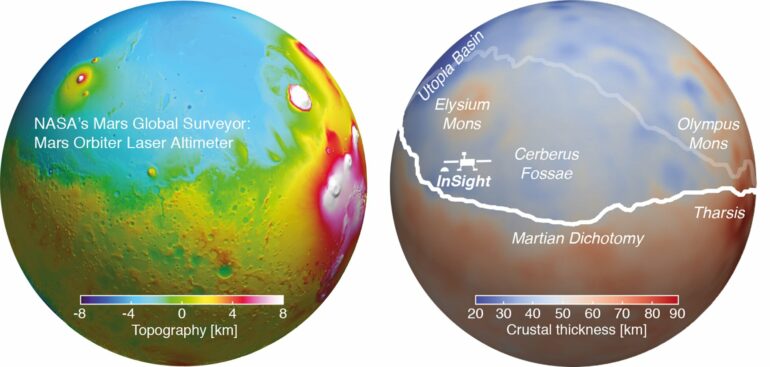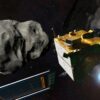A strong quake in the last year of the NASA Mars InSight mission, enabled researchers at ETH Zurich to determine the global thickness and density of the planet’s crust. On average, the Martian crust much thicker than the Earth’s or the moon’s crust, and the planet’s main source of heat is radioactive.
After more than three years of daily monitoring and with the power levels decreasing on InSight’s seismometer, researchers were rewarded with data from a sizeable Marsquake in May 2022. The surface waves observed from this estimated 4.6 magnitude quake not only traveled from the quake’s source to the measuring station, they also continued to travel around the entire planet several times. This data not only provided information about specific areas of Mars, but also enabled a global view of the planet.
“From this quake, the largest quake recorded during the entire InSight mission, we observed surface waves that circled Mars up to three times,” says Doyeon Kim, seismologist and lead author of a study just published in the journal, Geophysical Research Letters. In order to gain information about the structure that the waves passed through, the researchers measured how fast these waves propagate at different frequencies.
These seismic velocities provide insights into the interior structure at different depths. Previously, observed surface waves from the two large meteorite impacts also allowed regional findings along their specific propagation paths. “Now, we have seismic observations that represent the global structure,” says Kim.
Comparing data from Mars with that of the Earth and the moon
Combining their newly obtained results with existing data on the gravity and topography of Mars, the researchers were able to determine the thickness of the Martian crust. It averages 42 to 56 kilometers (26–35 miles). On average, the crust is thinnest at the Isidis impact basin at ~10 km (6 miles), and thickest at Tharsis province at ~90 km (56 miles). To put this into perspective, seismic data indicates that the Earth’s crust has an average thickness of 21 to 27 kilometers (13–17 miles), while the lunar crust, as determined by the Apollo mission seismometers is between 34 and 43 kilometers (21–27 miles) thick.
“This means that the Martian crust is much thicker than that of the Earth or the moon,” says Kim. Generally, smaller planetary bodies in our solar system have a thicker crust than the larger bodies. Kim explains, “We were fortunate to observe this quake. On Earth, we would have difficulty determining the thickness of the Earth’s crust using the same magnitude of quake that occurred on Mars. While Mars is smaller than the Earth, it transports seismic energy more efficiently.”
One of the most important results of this research concerns the difference between the northern and southern hemispheres of Mars. This contrast has been observed for as long as there have been telescopes; it is particularly visible in images from Mars satellites. The northern hemisphere on Mars consists of flat lowlands, while there are high plateaus in the south. The division between northern lowlands and southern highlands is called a Martian dichotomy.
Similar crust density and radioactive heat
“One might think that this difference could be explained by two different rock compositions,” says Kim. “One rock would be denser than the other.” While the composition may be the same in the north and south, the thickness of the crust varies. If the crust is thicker in the south, there would be less dense Martian mantle material underneath it, whereas a thinner crust in the north would have more of this dense, heavier material.
Precisely what have the researchers have been able to prove? “Based on the seismic observations and the gravity data, we show that the density of the crust in the northern lowlands and the southern highlands is similar,” they write. In contrast, the crust in the southern hemisphere extends to a greater depth than in the northern hemisphere. “This finding is very exciting and allows an end to a long-standing scientific discussion on the origin and structure of the Martian crust,” says Kim. After all, analysis of meteorite impacts on Mars last year already provided evidence that the crusts in the north and south are made of the same material.
Further conclusions can also be drawn from the thick Martian crust. “Our study provides how the planet generates its heat and explains Mars’ thermal history,” says Kim. As a single-plate planet, the main source of heat produced in the interior of Mars today is a result of the decay of radioactive elements such as thorium, uranium, and potassium. The study found that 50% to 70% of these heat-producing elements are found in the Martian crust. This high accumulation could explain why there are local regions underneath where melting processes may still be taking place today.
More information:
Doyeon Kim et al, Global crustal thickness revealed by surface waves orbiting Mars, Geophysical Research Letters (2023). DOI: 10.22541/essoar.167810298.85030230/v1
Citation:
Researchers determine global thickness and density of Martian crust (2023, May 16)



